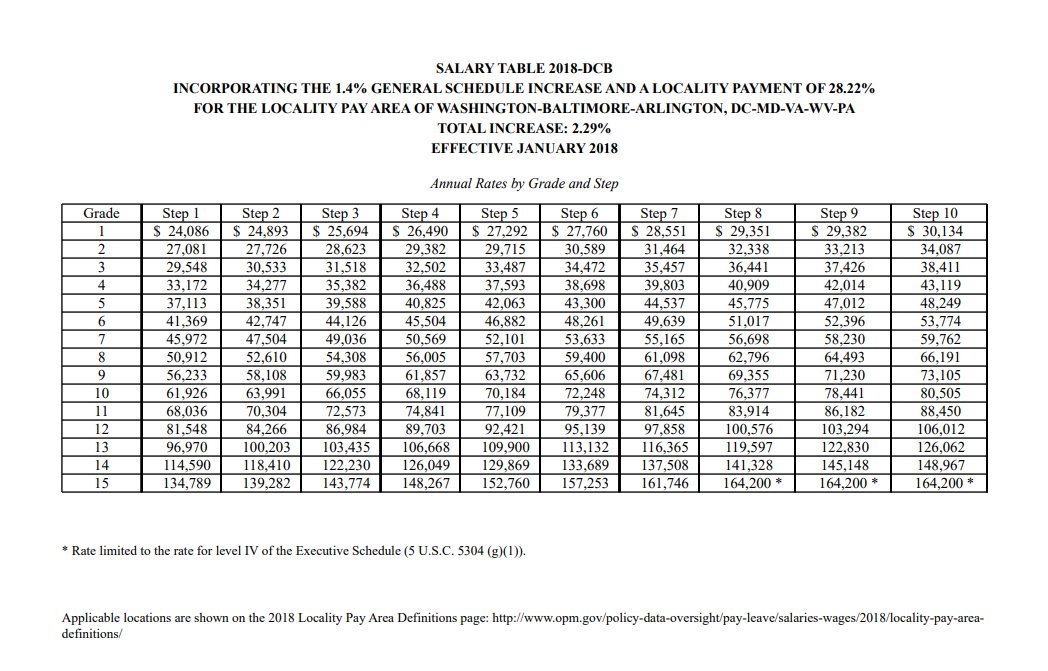
President Trump just issued a letter indication his intention to deny the upcoming 2.1% pay increase for civilain General Schedule (GS) federal employees, set to go into effect in January 2019. (See attachment)
Here's a quick explainer on how federal pay increases work.
Here's a quick explainer on how federal pay increases work.

Pay increases for civilan GS federal employees are currently governed by the Federal Employees Pay Comparability Act (FEPCA) of 1990 (P.L. 101-509). The pay for anyone on the GS scale is determined by 3 things: grade, step, and locality. Here's the basic GS cale for 2018. 

Increasing one's grade is the equivalent of getting a promotion. Increasing a step (within a grade) typically happens through longevity, simply by staying in the same position for an additonal year (or multiple years). Locality pay is an ajustment based on where the job is based.
Here's the GS scale for the DC metro area, which has a locality increase over the GS base scale of 28.22%. 

Now, federal employees get pay increases by getting promotion to new grades or by increasing their step within their grade. These are considered merit increases.
But the entire scale is also increased under the FEPCA, under an annual formula, for the purpose of keeping federal jobs competitive with the priate sector. It's called a "pay adjustment" but it operates the same as what many people call a "COLA" --- a cost-of-living adjustment.
The formula is pretty simple: federal GS employees get an increase 0.5% less than private sector wage increases, based on the ECI (employment ost index). You measure the ECI in the 3rd quarter of year 1 and year 2, and the difference is the pay increase for year 3.
So the 2.1% increase scheduled for January 2018 was based on the difference between the ECI in the third quarter of 2016 and 2015, minus 0.5%. Yes, there is a 15 month lag between the measurement and the enactment. This is the national across-the-board increase.
Locality pay increases are different. The FEPCA aims to get local pay for GS employees within 5% of comparable work in the private sector, and authorizes those changes to locality pay until such a target is reached.
Locality changes are assessed using BLS data by the federal Pay Agent, a board composed of certain federal officials, governed under OPM regulatoins.
For both the national increase an locality increase, the FEPCA gives POTUS discretion to limit pay adjustments through executive order in the "event of serious economic conditions or a national emergency affecting the general welfare."
Because of this, the formula-based pay adjustments are often reduced under an alternative plan of the president, which must be submitted to Congress by September 1 uner the FEPCA. That's why you are hearing about this today: Trump just sent his official notificatoin to Congress.
These alternative plans are common. Often, POTUS submits an alternative plan, Congress then considers and includes a specific pay adjustment in an appropriations act, superseding the FEPCA. Usually, these adjustments allow POTUS to divide them betwen national an local increases.
So pay adjustments come in three flavors: formula under the FEPCA; formula under the FEPCA adjusted by POTUS; or superseding congressional statute with or without discretion to POTUS. Here's the exec order implementing 2018 pay increase of 1.9%.
gpo.gov/fdsys/pkg/FR-2…
gpo.gov/fdsys/pkg/FR-2…
This pay adjustment came after Trump had called for a freeze, and Congress had, by law, implemented the final number.
Trump's alternative plan for 2019 again is to have zero pay adjustment, for both the national increase and the locality pay. IMPORTANT NOTE: this is NOT removing the current locality pay; it is simply not increasing it. In essence, Trump is seeking to freeze federal pay levels.
Congress, of course, is always free to object to the POTUS alternative plan an provide for, by statute, an increase (like last year). Of couse, POTUS could veto that.
My hunch is that this could go a number of ways on the Hill. Members could simply agree with Trump an freeze federal pay for 2019. Plausible. Also plausible: the raise it in an approprations package and dare POTUS to veto it (he'd likely eat it). Who knows.
• • •
Missing some Tweet in this thread? You can try to
force a refresh





